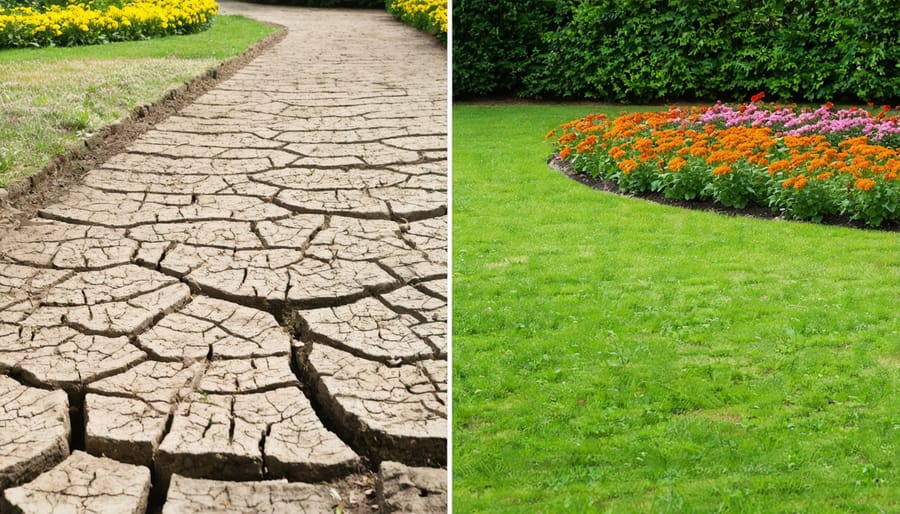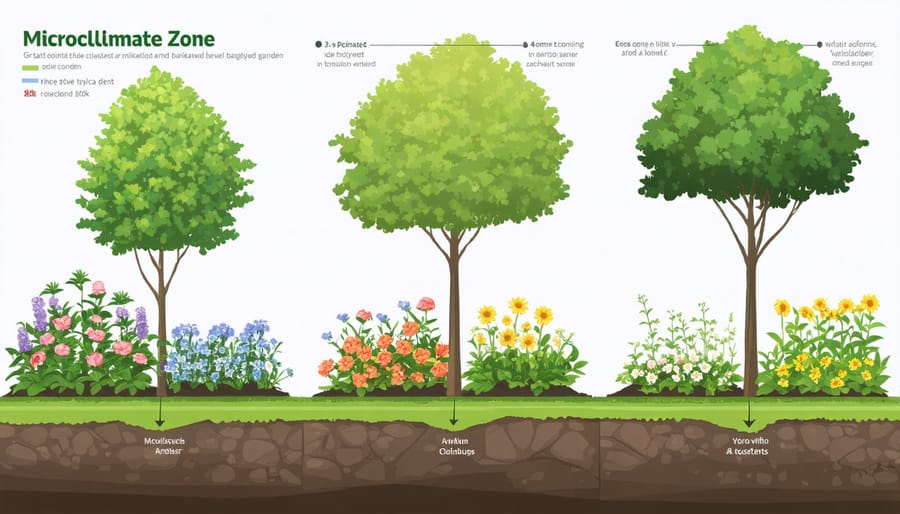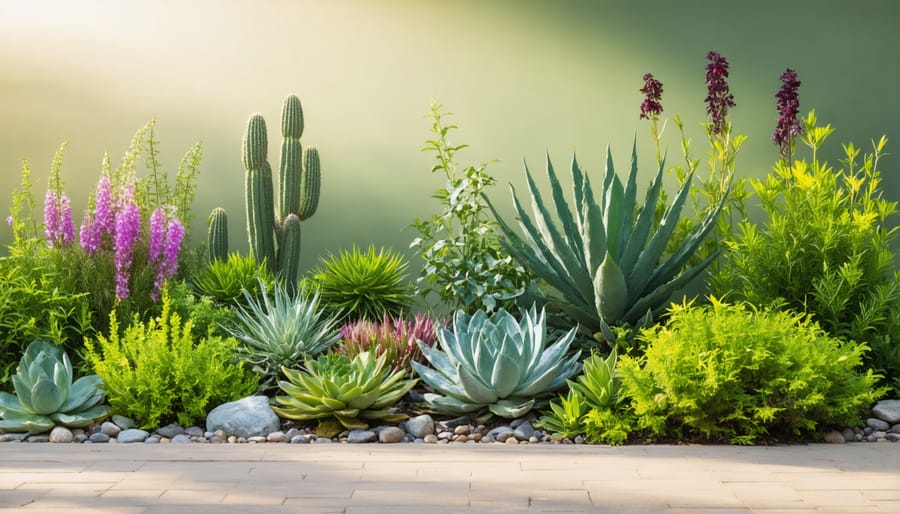Transform your garden into a climate-resilient oasis by implementing water-smart irrigation systems, selecting drought-tolerant native plants, and creating strategic shade zones. As extreme weather events become more frequent, these adaptable farming practices not only protect your investment but also contribute to a more sustainable future.
Climate-smart agriculture combines traditional wisdom with modern innovation, allowing home gardeners to maintain beautiful, productive spaces while reducing water consumption by up to 50%. Through techniques like mulching, companion planting, and soil moisture monitoring, you can create a garden that thrives in changing conditions while supporting local biodiversity.
These proven methods help protect against temperature fluctuations, reduce water waste, and build soil health naturally. Whether you’re starting a new garden or adapting an existing landscape, implementing these climate-smart practices ensures your outdoor space remains vibrant and resilient throughout the seasons. By making these adjustments now, you’re not just creating a more sustainable garden – you’re participating in a global movement toward smarter, more responsible land stewardship.
Why Your Garden Needs Climate-Smart Plants Now
Local Climate Changes Affecting Your Garden
Your garden is likely experiencing the effects of climate change, even if you haven’t noticed the subtle shifts. Many homeowners report longer dry spells, unexpected frost dates, and more extreme weather events that directly impact their plants. These changes can show up as yellowing leaves during unusual heat waves, frost damage during typically mild seasons, or plants blooming at unexpected times.
Pay attention to specific signs in your garden: Are your plants flowering earlier than usual? Do you notice new pests that weren’t common in your area before? Is your soil drying out faster than in previous years? These observations can help you adapt your gardening strategy.
Keep a simple garden journal to track weather patterns, noting when you experience heavy rains, drought periods, or temperature extremes. This information becomes invaluable when planning future plantings and adjusting your garden care routine. Consider installing a rain gauge and maintaining a basic weather station to better understand your microclimate.
Remember, local climate changes don’t mean you need to give up gardening – they simply signal it’s time to adapt your approach with resilient plants and smarter growing practices.

Benefits Beyond Climate Resilience
When you embrace nature-friendly growing practices, you’ll discover benefits that go far beyond climate resilience. Climate-smart plants typically require significantly less water than traditional options, which means lower utility bills and less time spent on irrigation. These hardy varieties have developed robust root systems that efficiently capture and retain moisture, making them perfect for busy homeowners.
You’ll also spend less time on maintenance since these plants have naturally adapted to thrive in challenging conditions. Say goodbye to constant pruning, fertilizing, and pest management – these resilient plants largely take care of themselves. Many climate-smart varieties also provide year-round interest with evergreen foliage or extended blooming seasons, ensuring your garden looks beautiful across all seasons.
Another fantastic perk is the positive impact on local wildlife. These plants often serve as excellent habitat for beneficial insects, birds, and pollinators, creating a vibrant ecosystem right in your backyard. Plus, their strong root systems help prevent soil erosion, improving your property’s overall stability and health.
Smart Plant Selection Strategies for Your Climate Zone
Understanding Your Microclimate
Your garden’s microclimate is like its own mini ecosystem, influenced by factors that might be quite different from your general climate zone. Understanding these unique conditions is key to successful climate-smart gardening. Start by observing your space throughout different times of the day and seasons.
Take note of how sunlight moves across your garden. Which areas get full sun, partial shade, or complete shade? Track these patterns for at least a few days. Next, identify wind patterns and potential frost pockets. Buildings, fences, and large trees can create sheltered areas or funnel strong winds through your garden.
Soil conditions vary significantly even within small spaces. Consider investing in precision soil monitoring tools to understand moisture levels, pH, and nutrient content in different areas. Pay attention to how water moves through your garden during rainfall – notice any particularly dry or waterlogged spots.
Temperature variations are crucial too. Urban areas often create heat islands, while low-lying areas might collect cold air. Use a simple thermometer to check temperatures in different garden zones throughout the day. This information will help you choose plants that thrive in your specific conditions and implement effective climate-smart strategies for your unique space.
Remember, your microclimate isn’t static – it changes with the seasons and can be modified through thoughtful landscaping choices. Regular observation and documentation will help you make informed decisions about plant selection and care.

Drought-Tolerant Stars for Your Garden
Looking to create a beautiful garden that thrives even during dry spells? These drought-tolerant superstars will keep your garden looking vibrant while saving water. Let’s explore some tried-and-true options that combine beauty with resilience.
Lavender stands out as a perfect choice, offering both stunning purple blooms and a delightful fragrance. This Mediterranean native actually prefers dry conditions and will reward you with years of low-maintenance beauty. Russian Sage is another purple powerhouse that laughs in the face of drought, creating impressive swaying masses of color from mid-summer to fall.
For groundcover, consider Sedum varieties like ‘Autumn Joy’ or ‘Dragon’s Blood.’ These succulents store water in their thick leaves and produce attractive flowers that pollinators love. Yarrow is another excellent option, offering flat-topped flower clusters in various colors while requiring minimal water once established.
Don’t forget ornamental grasses! Blue Fescue and Mexican Feather Grass add movement and texture to your garden while being incredibly drought-resistant. For dramatic impact, consider Yucca plants, which offer architectural interest with their sword-like leaves and impressive flower spikes.
Pro tip: Group these plants together in your garden based on their water needs. This practice, known as hydrozoning, helps create an efficient and sustainable landscape that’s both beautiful and water-wise.
Heat-Resistant Plant Options
As our climate continues to warm, choosing heat-resistant plants is becoming increasingly important for sustainable gardening. These hardy varieties not only survive but thrive in high-temperature conditions, making them perfect for creating resilient gardens.
Drought-tolerant Mediterranean herbs like lavender, rosemary, and sage are excellent choices that combine practicality with beauty. These plants have silvery-green leaves that reflect sunlight and require minimal watering once established. For vibrant color, consider heat-loving flowers such as lantana, verbena, and zinnias, which produce abundant blooms even during scorching summer days.
Vegetables aren’t left out of the heat-resistant category. Plants like okra, sweet potatoes, and cherry tomatoes are particularly well-suited to warm conditions. These crops often produce better yields in higher temperatures compared to their cool-season counterparts.
For ground cover and ornamental purposes, sedums and succulents are outstanding choices. Their thick, fleshy leaves store water efficiently, and many varieties offer stunning color variations throughout the season. Native plants specific to your region are also smart choices, as they’ve naturally adapted to local climate conditions over thousands of years.
When planning your heat-resistant garden, remember to group plants with similar water needs together. This practice, known as hydrozoning, helps maintain optimal growing conditions while conserving water. Start with a few of these hardy plants and gradually expand your heat-resistant garden as you gain confidence in growing them.
Design Tips for a Climate-Smart Garden
Creating Beautiful Plant Combinations
Creating visually appealing plant combinations in a climate-smart garden is both an art and a science. Start by selecting plants with varying heights to create depth and visual interest – tall grasses or shrubs in the back, medium-sized plants in the middle, and ground covers or shorter plants in the front. This layered approach not only looks beautiful but also helps with water retention and soil protection.
Consider color harmonies that work year-round. Combine plants with different blooming seasons to ensure continuous visual interest. For example, pair drought-resistant lavender with ornamental grasses and seasonal wildflowers. The purple blooms, golden grasses, and changing wildflower colors create a dynamic display while maintaining climate resilience.
Texture is another crucial element. Mix plants with different leaf shapes and sizes – like the broad leaves of sage alongside the feathery foliage of yarrow. This creates visual contrast while ensuring all plants share similar water and sunlight needs.
Group plants with similar water requirements together, creating hydrozones. This practice not only looks organized but also makes irrigation more efficient. Consider incorporating native plants, which naturally complement each other and are adapted to local climate conditions.
Don’t forget about seasonal changes. Include evergreen plants as anchor points in your design, then supplement with climate-adapted flowering plants that provide bursts of color throughout the year. Plants like sedum, Russian sage, and native grasses offer both drought tolerance and year-round visual interest.
Remember to space plants appropriately, allowing room for growth while maintaining their aesthetic appeal. This prevents overcrowding and reduces competition for water and nutrients, creating a sustainable and beautiful garden that thrives in changing climate conditions.

Seasonal Planning for Year-Round Interest
Creating a garden that stays vibrant throughout the year requires thoughtful planning and an understanding of your local climate patterns. Start by mapping out your garden’s seasonal highlights, ensuring you have plants that peak during different times of the year.
For spring, consider climate-resilient bulbs like daffodils and tulips that can handle unpredictable temperature swings. These early bloomers provide essential food for pollinators while adding splashes of color to your garden. Follow up with drought-tolerant perennials like lavender and salvia that will carry your garden through summer’s heat.
Summer planning should focus on heat-hardy plants that won’t wilt under intense sun. Native wildflowers, ornamental grasses, and herbs like rosemary and thyme offer both beauty and functionality while requiring minimal water. Consider installing shade cloth or utilizing companion planting to protect more delicate species during extreme heat waves.
Fall interest can be maintained with late-blooming asters, sedums, and ornamental grasses that provide texture and movement. Choose plants with colorful foliage that will create stunning autumn displays without requiring additional resources.
For winter appeal, incorporate evergreen shrubs and trees that maintain structure and color year-round. Plants with interesting bark patterns or persistent berries add visual interest during dormant months. Consider installing weather-resistant hardscaping elements like stone paths or decorative walls to maintain garden structure when plants are dormant.
Remember to group plants with similar water and sunlight needs together, creating efficient micro-climates that maximize resource use while maintaining aesthetic appeal throughout the changing seasons.
Maintaining Your Climate-Smart Garden
Smart Watering Techniques
Making every drop count in your garden doesn’t have to be complicated. With modern smart irrigation control systems and thoughtful watering techniques, you can keep your plants thriving while conserving water.
Start by grouping plants with similar water needs together, creating hydrozones that make watering more efficient. Install drip irrigation or soaker hoses to deliver water directly to plant roots, reducing evaporation and waste. These systems work especially well when covered with mulch, which helps retain moisture and regulate soil temperature.
Consider installing a rain sensor or moisture meter to prevent overwatering on rainy days. Water early in the morning or late in the evening when evaporation rates are lowest. Deep, infrequent watering encourages stronger root growth compared to frequent shallow watering.
For container gardens, use self-watering planters or water-storing crystals to maintain consistent moisture levels. Don’t forget to collect rainwater in barrels – it’s free, natural, and perfect for your plants!
Seasonal Care Calendar
A successful climate-smart garden starts with following nature’s rhythms. In spring (March-May), focus on soil preparation, adding organic matter and testing pH levels. Plant warm-season crops and install garden automation solutions like moisture sensors and smart irrigation systems.
Summer (June-August) demands consistent moisture monitoring and mulching to retain water. Establish a regular pruning schedule for optimal growth and harvest mature crops during early morning hours to minimize water loss.
Fall (September-November) is perfect for soil improvement and planting cover crops. Collect fallen leaves for composting and protect sensitive plants from early frost. Install cold frames or row covers for extended growing seasons.
Winter (December-February) is your planning period. Maintain soil health through minimal disturbance, review past season’s successes, and order climate-resistant seeds for spring. Use this time to repair tools and upgrade irrigation systems for the upcoming growing season.
Remember to adjust these timeframes based on your specific climate zone and local weather patterns. Keep detailed records of weather events and plant responses to fine-tune your calendar for future seasons.
Transforming your garden into a climate-smart oasis doesn’t have to be overwhelming. By implementing the practices we’ve discussed – from water-wise irrigation and soil management to selecting resilient plants and creating biodiversity – you’re not just creating a beautiful outdoor space; you’re contributing to a more sustainable future. Start small by choosing one or two techniques that resonate with you, and gradually expand your eco-friendly practices as you become more comfortable. Remember, every climate-smart choice you make in your garden helps build resilience against changing weather patterns while reducing your environmental impact. Your garden can be both beautiful and sustainable, serving as an inspiration for others in your community. Take that first step today, and watch your climate-smart garden flourish while making a positive difference for our planet.
